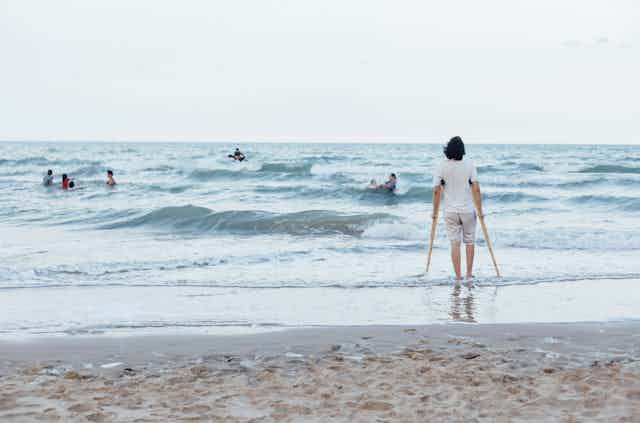This article is part of a series to mark the International Day of Persons with Disabilities on December, 3
The United Nations recommends governments ensure no one gets left behind before, during and after a disaster. This includes people with disabilities.
Disasters are a leading cause of disability worldwide. Evidence shows people with disabilities are up to four times more likely to die in a disaster than the general population.
Indonesia is prone to various environmental hazards like earthquakes and volcanic eruptions due to its location in the Ring of Fire, an area in the Pacific Ocean hosting the world’s most active volcanoes.
People with disabilities make up 8.56% of the Indonesian population, which is around 21.1 million people. But during a disaster, people with disabilities are often left behind.
Recent studies suggest people with disabilities have difficulty accessing life-saving early warnings and other information because they are socially excluded.
Governments and non-governmental organisations (NGOs) rarely see people with disabilities during a disaster in Indonesia. Due to a lack of awareness of disability issues, people with disabilities live with stigma. This makes them vulnerable and unable to access disaster response services.
Leading initiatives
Involving people with disabilities in the emergency response is vital if we want to prevent more people becoming disabled, or dying, as a result of disaster.
The UN has called for the empowerment of people with disabilities so they are not only involved in disaster management, but can also lead. This is important so every disaster response also meets the need of people with disabilities.
There are already many discussions on how to involve people with disabilities in disaster management. However, we rarely discuss their leadership role. My research tried to fill this gap.
I gathered data by comparing multiple case studies of disaster programs initiated and managed by three local organisations for people with disabilities, known as disabled people organisations (DPOs), in three provinces – Central Java, Yogyakarta and West Sumatra.
From my research, I have identified at least three ways local disabled people organisations can take the lead in disaster management.
1. Building the capacity of disability organisations
Developing the skills and knowledge of disabled people organisations is an early step in enhancing the confidence they need to engage in disaster-related programs.
My colleagues and I have developed a model for DPO capacity development.
The model involves in-class and field practice sessions to build the skills of DPO members. For example, members are trained to collect data such as the number of people living with disabilities and barriers they face in relation to disasters. They use the data to advocate for disability issues to government and NGO workers.
We have tested this model in more than 50 disabled people organisations in four provinces in Indonesia. The model led to better collaboration between DPOs and other organisations in disaster management.
I observed two international organisations - Arbeiter Samariter Bund (ASB) and CBM Indonesia, which have implemented capacity development strategies for disabled people organisations during Central Sulawesi’s disaster last year.
After the Palu earthquake, ASB trained DPOs in Palu, Central Sulawesi and neighbouring districts. It also partnered with them to supply real-time data on the needs of people with disabilities through an inclusive post-disaster assessment. Under ASB programs, DPOs disbursed hygiene kits in shelters.
Meanwhile, CBM Indonesia provided contacts comprising members of local DPOs to help ageing people and people with disabilities affected by the disaster. CBM trained them as disability activists.
They inform the authorities about the living conditions and the needs of people with disabilities who became victims of the Palu earthquake.
2. Directly funding organisations
The second way involves direct funding. International humanitarian organisations and donors must channel their aids directly to local organisations.
This will allow local DPOs to plan and implement their own disaster management programs that meet the needs of disabled victims.
Evidence from my research shows the three DPOs were able to manage direct funding of up to US$20,000 from international donors. The funding contributed to improving the preparedness of local communities in three provinces.
3. Technical assistance
Another way to support the leadership of DPOs in disaster management is by providing technical assistance.
Research has shown organisational and financial capacities of DPOs in low middle-income countries, including in Indonesia, are still limited.
DPOs need technical assistance on how to develop and implement projects to build their capacities. International organisations and donors can provide such support. By having such support, DPO can strengthen their capacity.
Wider opportunity for inclusion
The Indonesian government has encouraged the involvement of people with disabilities in disaster management. But it was not until last year it issued a new regulation that paved the way for people with disabilities to be part of the disaster management response.
Issued after a tsunami and earthquake hit Central Sulawesi, the regulation instructs international humanitarian organisations to partner with local communities in their aid distributions.
The regulation is expected to widen opportunities for DPOs to be involved in disaster response and even lead the efforts.
Their involvement is expected to reach disabled victims during disasters.
The practice will replace the old system, under which international NGOs can distribute aid directly without involving local organisations. This has resulted in disaster management programs that often exclude people with disabilities.
Adding to the regulation, the government, donors and humanitarian actors wishing to work with DPOs can consider the above three approaches to ensure their disaster responses include everyone.


